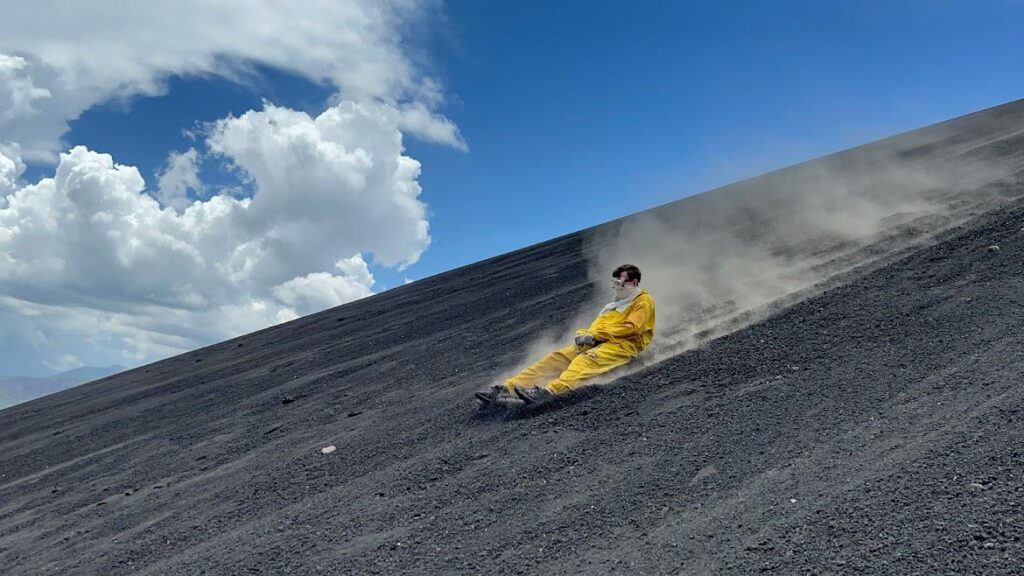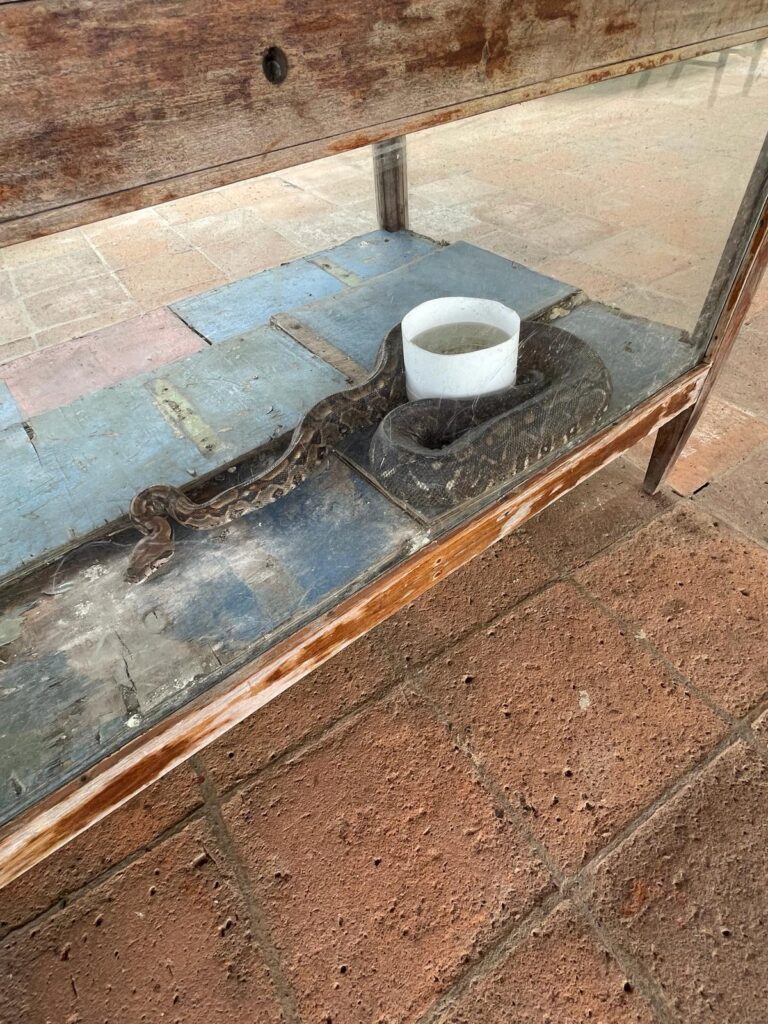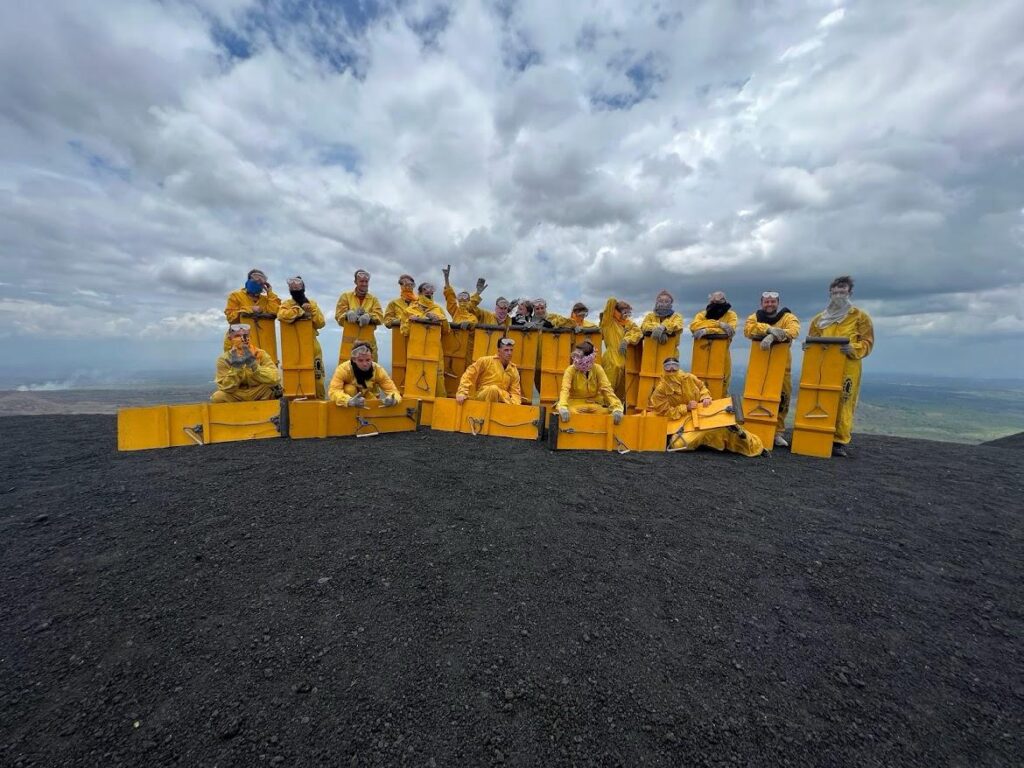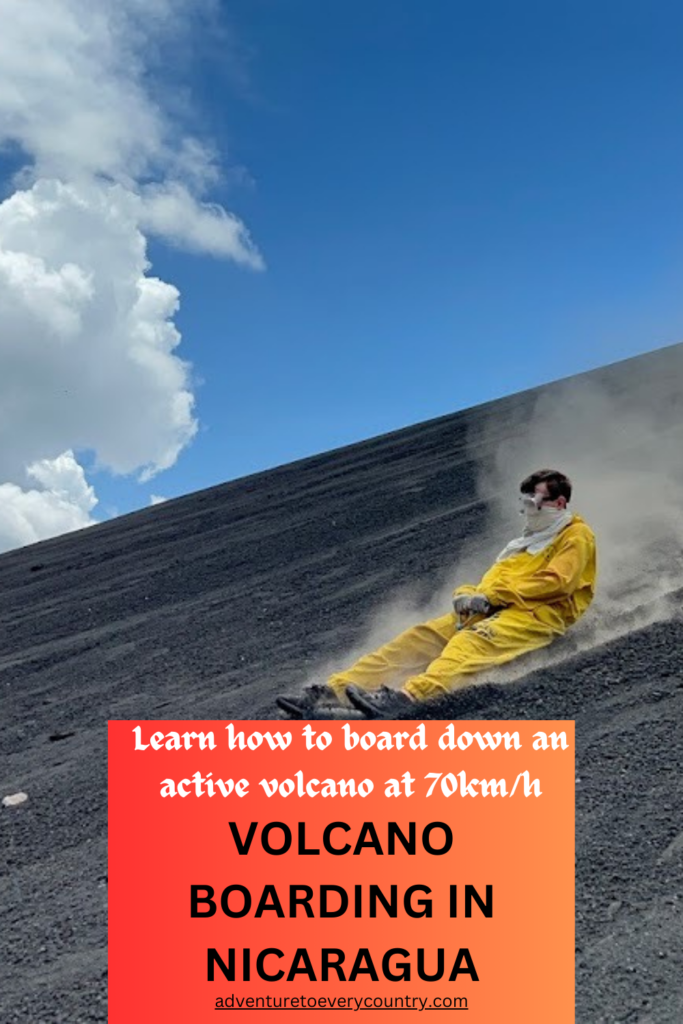Volcano Boarding In Nicaragua
Volcano boarding in Nicaragua is a unique activity that you can do in very few places globally. You’re seriously missing out if you don’t add this adventurous sport to your Central America itinerary.
You’ve heard of sandboarding right? Well volcano boarding is pretty much the same thing. Only you’re bombing down the side of a volcano at 70 km per hour (43 mph). Pretty cool huh?
This is an adventure activity with a little risk involved. So perhaps don’t tell your mother until you’re done here.
The risk is low however and you’ll receive protective clothing before going down, so don’t be scared and risk missing out on the experience of a lifetime.

Where Can I Do Volcano Boarding In Nicaragua?
Volcano boarding in Nicaragua takes place at Cerro Negro Volcano near the city of Leon. It takes 54 minutes to reach Cerro Negro Volcano from Leon. For anyone wondering, “Cerro Negro” means black hill. Very apt since the volcano is, well, black and shaped like a hill.
Tours run regularly from Leon, which is an easy city to reach in Nicaragua. Leon is a 2-hour drive from the Honduras border, and one of the easiest cities to get to if you’re coming down from Nicaragua’s northern neighbour. Leon is just a 1 hour 40 minute drive from the capital Managua.
Cerro Negro is 728m in height (2,388 ft) and takes about 30-45 minutes to hike up with your board. The time range varies depending on the speed of your group. It’s a pretty easy hike though so the average person shouldn’t have any problems. If you’re a slow hiker, don’t worry, the tour guides will support you here.
It is worth noting that you’re very much exposed to the sun on the way up, with no shade whatsoever to protect you. And the sun can be pretty intense. You will be carrying your board and a backpack with your protective clothing inside. My advice would be to wear sun cream and drink plenty of water.
How Much Does It Cost To Do Volcano Boarding In Nicaragua?
For such a bucket list activity you’d imagine volcano boarding would be expensive. That’s not true! Nicaragua is one of the cheapest countries in the world, and that is reflected in the price of activities here.
Volcano boarding in Nicaragua costs US$30-US$40 with tours costing from US$25-US$35 and a US$5 entrance fee on top.
You can choose between a sunrise tour, a sunset tour and a day tour. The two biggest tour operators are Volcano Day and Bigfoot Hostel. I’ll provide more detail on both further on in this guide, but I went with Volcano Day and could not have been happier with how things turned out!
Is It Safe To Board A Volcano In Nicaragua?
Volcano boarding is relatively safe if you wear appropriate clothing and listen carefully to instructions given by your tour guide. There is a risk involved, but that risk is minimal if you take sensible precautions.
No volcano boarding deaths have ever been recorded. In fact more people have been killed by porridge than volcano boarding.
Injuries can occur, but this is unlikely if you wear protective clothing which is designed to protect your body. The clothing is key here, because if you come off your board then you will be hurtling down gravel at speeds comparable to the average zebra. And that’s gonna hurt. Think of why motorcyclists wear leather, and you’ll know why volcano boarders also wear protective clothing.
And it’s effective. I lost control towards the bottom, flew off my board, and ended up with nothing worse than a load of gravel in my shoes.
You can control your speed, which is a good idea as breaking bones isn’t impossible if you come off your board here. Leaning backwards with your feet in the air will ensure you pick up speed which adds to the risk factor. Sit up straight if you wish to slow down and lower your risk.
Cerro Negro is an active volcano which most recently erupted in 1999. It has erupted over 20 times since it was first formed around the year 1850.
There is an information office 1km from the volcano which has a snake in a box. My tour guide said the snakes’ purpose is to monitor volcanic activity, as erratic behavior from the snake generally means an eruption is imminent. Fortunately the snake was rather sluggish during my trip to Cerro Negro!

What To Wear For Volcano Boarding
There are two things to take into account when you go volcano boarding: safety and comfort. Let’s start with the essentials to make sure you stay safe and minimise the risk of injury during your descent:
- Jumpsuit: This protective garment protects everything from your neck down to your ankles, with the exception of your hands. If you come flying off your board as I did, this will soften the blow and ensure you can walk away from any accidents with nothing worse than a sheepish grin on your face. It will save your clothes and skin from being ripped apart by the gravel
- Gloves: The gloves you will be offered by your tour are sturdy and just like the jumpsuit, they will ensure your skin doesn’t get ripped to shreds should you make high-speed contact with the gravel. Stating the obvious here, but the gloves protect your hands
- Goggles: Even if you stay on the board, gravel will fly up into your face at high speeds. Needless to say, this will cause some real damage if it gets in your eyes. Fortunately you will be given goggles to avoid this. The goggles are highly effective at protecting your eyes, so make sure you wear these
- Bandana: The famous attire associated with 90s US gangsters has a more positive use out here. I wore one covering my nose, mouth and neck to avoid inhaling a load of dirt and rocks. An important item to wear during this activity
And now, let’s cover the items that aren’t essential for volcano boarding safety, but will make things more comfortable for you and help ensure the hike goes as smoothly as possible:
- Hiking boots: This isn’t a difficult hike, certainly not on the level of Guatemala’s challenging Volcan Acatenango trek. But hiking boots will make the short 30-45 minute ascent easier and minimise your chances of taking a tumble
- Sunglasses: You won’t be able to wear these for the descent when you have goggles on instead, so be sure to bring a protective case you can keep them in. Your items will be held in a little bag on your back, so don’t worry about having a place to store it. Your sunglasses will protect against the intense rays on the heavily-exposed volcano as you hike up in the heat
- Sun cream: There is no shade on the volcano, you cannot escape the intense sun. Therefore sun cream is strongly advised to avoid looking like a beetroot by the time you make it back to the bottom

How Fast Can I Go Down The Volcano?
Sometimes it can be a bit tricky to get going, and your board may get stuck in the gravel. But when you go, you go hard!
Average speeds are around the 60-70km/h mark (37-43 mph). This means you are going about as fast as a kangaroo or zebra!
It is possible to board either sitting or standing. Standing like a surfer is much harder, riskier and tougher to pick up speed. Therefore almost everyone will choose to sit instead.
The record speed recorded for a standing descent was 45.06 km/h (28 mph) by Chase Boehringer of the US who achieved this feat at Paricutin Volcano in Mexico.
The record recorded for a sitting descent was around 90 km/h (54 mph) set by an Israeli woman at Cerro Negro itself.
Tours Offering Volcano Boarding In Nicaragua
Almost everyone who goes volcano boarding in Nicaragua will go with one of the “big two” companies situated in Leon. As mentioned earlier, they are Volcano Day and Bigfoot Hostel. Let’s look at what both have to offer:
Volcano Day
Volcano Day is the company I went with and they were excellent. They offer four main tours focusing specifically on volcano boarding, and an additional four combination packages that include an additional activity.
Main Tours
- Volcano Boarding BASIC ($25): A 4.5 hour tour that takes place from 8:30am-1pm. It includes the board, protective clothing (jumpsuit, goggles and gloves), a string bag to carry your belongings up and down the volcano, return transport from Leon in a trailer where you’re sat in the back with other boarders, an English-speaking tour guide and photos/videos which you will be sent after the tour. This tour claims not to include a bandana, although I was given one anyway. I was also given a free Volcano Day t-shirt, which is apparently only included in the ALL-IN tour. The $5 entrance fee is NOT included
- Volcano Boarding ALL-IN ($35): An 11-hour tour from 8am-7pm that includes all of the above plus drinks, snacks, lunch, a free t-shirt and a shuttle to the beach afterwards for sunset. Although as mentioned, I was given a t-shirt anyway on the cheaper package
- Volcano Boarding SUNSET ($35): A 6-hour tour from 1pm-7pm. It’s similar to the ALL-IN tour, with two differences. One is that dinner is provided instead of snacks and lunch. The other is that there is no beach trip afterwards
- Volcano Boarding TWICE ($50): A 12-hour tour from 7am-7pm. This one is the same as the ALL-IN tour, but you go down the volcano twice. Everything else included is exactly the same. So essentially, if you wish to do the BASIC tour twice, don’t. You will save $20 and get food, drinks and a beach trip included if you purchase this package instead
Combination Tours
- Volcano Boarding, El Hoyo + Asososca ($95): A 28-hour tour from 8am-midday the following day with everything the Volcano Boarding ALL-IN package includes plus an additional breakfast, dinner and two lunches instead of one. It also involves treks up El Hoyo Volcano for sunset, camping by the crater (camping equipment is included) and a morning swim in Lake Asososca to end the tour. Save $15 compared to doing the Volcano Boarding ALL-IN and El Hoyo/Lake Asososca Tours separately
- Volcano Boarding + Talisca Sunset ($80): An 8-hour tour from 8am-8pm. This is the Volcano ALL-IN package with dinner thrown in on top, plus a visit to smoking Telica Volcano in time for sunset. This is the same price as doing Volcano Boarding (ALL-IN) and the Telica Sunset tour separately. Therefore combining the two will save you hassle, but not money
- Volcano Boarding + Lake Asososca ($70): A 10-hour tour from 8am-6pm. This again is the Volcano Boarding All-IN tour, this time combined with a swim in Lake Asososca. You can also rent a kayak for an additional $10. This will save you $5 compared to doing the Volcano Boarding All-IN and Lake Asososca tours separately
- Volcano Boarding + Mangroves ($80): Another 10-hour tour from 8am-6pm. This is the Volcano Boarding ALL-IN tour with dinner included on top. The extra excursion here is a boat ride through nearby mangroves where you can see the local plants and wildlife. The best time to do this tour is between November and January when you can also visit a turtle hatchery where baby turtles hatch and head to the ocean. Save $15 compared to doing the Volcano Boarding ALL-IN and mangroves tours separately.
Bigfoot Hostel
The other major volcano boarding tour operator in Leon is Bigfoot Hostel.
They offer three packages and they all cost the same – $35. The packages are: Volcano Boarding DAY TOUR, Volcano Boarding SUNRISE and Volcano Boarding SUNSET. All three include the same things aside from the meal and the timings. Let’s look at what all tours include, and what the small differences are between each one.
- All tours include: Return transport to Cerro Negro Volcano, an English-speaking guide, protective clothing, fruit, several pictures, a free t-shirt, a speed radar gun to track your speed boarding down the volcano and free drinks
- Volcano Boarding DAY TOUR: A 5-hour tour from 9am-2pm. It also includes lunch at a local family home near Cerro Negro Volcano. You will be picked up from your hostel in Leon between 8:15am and 9am.
- Volcano Boarding SUNRISE: A 6.5-hour tour from 3:15am-9:45am. This one includes breakfast at a local’s home near Cerro Negro. Pickup time for the SUNRISE tour is from 2:45am-3:15am.
- Volcano Boarding SUNSET: This tour is 7-hours long making it the longest of the three, lasting from 1pm-8pm. This time you will be going to a local’s home for dinner. However the SUNSET tour comes with an added bonus of a bonfire with marshmallows on the volcano. You will be picked up between 12:15pm and 1pm

Can I Go Volcano Boarding In Nicaragua Without A Tour?
Yes, but I’d strongly advise against this. Not necessarily for safety reasons, although it is safer to go with a professional guide who’s done this dozens or even hundreds of times.
But because it just isn’t worth the hassle. You would need to buy your own volcano board and protective equipment. And finding this would be incredibly difficult as these things aren’t sold anywhere near the volcano. Even in Leon, there weren’t shops selling volcano boards or jumpsuits.
Even if you can find a supplier, I’d imagine the cost would be far higher than paying for a tour regardless, especially considering the fact these tours are super affordable anyway.
The only scenario in which it may be worth buying your own equipment is if you happen to be in Leon for a long period and plan regular trips to Cerro Negro Volcano. Or if you are considering setting up your own volcano boarding tour company in Nicaragua.
Volcano Boarding History
Volcano boarding was invented in 2002 by Hungarian-American adventurer and journalist Zoltan Istvan, so he claims. He visited Mount Yasur, a volcano on Tanna Island in the little known Pacific island nation of Vanuatu.
A braver man than I, he decided to hike up the active volcano which spewed out balls of lava. His adventures were filmed for National Geographic and went viral, which is pretty impressive in the days before Facebook existed and viral content became commonplace. He even went back at night as lava lit up the night sky. It was during the day time he made his boarding attempt, but seeing the volcano at night shows just how much danger he was exposed to during his pioneering run.
Istvan split volcano boarding into two categories. Boarding down active volcanoes with deadly balls of lava and toxic fumes coming out, and boarding down dormant volcanos with a lot less risk.
Cerro Negro is an active volcano, the risk is still low. When I went there was no lava and there weren’t any visible fumes. Although I’m not going to pretend to be an expert on toxic fumes, so who knows what I was exposed to which wasn’t visible with the human eye. Volcano boarding is classified as an extreme sport, so this isn’t quite comparable to a nice pleasant walk in the park.
Are There Any Other Countries Where I Can Go Volcano Boarding?

If you want to go volcano boarding Nicaragua is the place to be. You can travel all across the world, but very few other countries offer opportunities to participate in this activity and none have the organised tours that you’ll find in Leon.
If you search for countries where you can go volcano boarding (or volcano surfing as it is sometimes known), you will read about destinations in Indonesia (Mount Bromo), Italy, Guatemala and more where you can do this activity. None of these countries offer tours. So if you were able to do it in these locations, you would have to source all the volcano boarding equipment and clothing yourself.
The same goes for Vanuatu. The country where the sport was invented does not offer any tours, therefore you’d have to arrange everything on your own which will be expensive and logistically challenging. And pretty dangerous, just watch videos on Mount Yasur and you’ll see why.
If you wanted to participate in any country other than Nicaragua, you certainly won’t be able to do it the easy way. So this is only an option for true adventurers!
My Own Experience Volcano Boarding In Nicaragua
Must admit I enjoyed the experience, and it’s a memory that will last a lifetime. But this isn’t something that will appeal to everyone.
For adrenaline junkies, and adventurous backpackers, it’s a rewarding activity. I guess anyone who comes to Nicaragua is adventurous to begin with, having chosen what I would consider the best country in Central America over the comfort of next-door tourist favourite Costa Rica. Although the less adventurous people out there may fancy something a little lighter, such as the magical Charco Verde wildlife reserve.
I met up with Volcano Day in Leon where they provided me with a string bag full of the necessary protective clothing. It also offered space to store my water and sunglasses. And trust me when I say you will need both. Although perhaps the sunglasses aren’t so necessary for a sunrise tour.
We then took a couple of shared vans with the rest of the tour group to Cerro Negro Volcano. The journey took just under an hour on pretty bumpy roads. There were no seatbelts, although this was pretty tame compared to Guatemala where I stood on the back of a cargo truck for a bumpy uphill journey where one slip would’ve meant serious injury or worse.
We stopped briefly at the information centre just before the volcano to see the snake which monitors volcanic activity.
He seemed pretty bored though and barely moved (a good thing, since an active snake means an imminent eruption) so off we went to the volcano.
Then we had a quick briefing from the guides in the car park before the ascent began.
The walk was short but the heat was intense. Sweat dripped down my body as we all lugged heavy boards up the slopes. We stopped a couple of times for water but in all honesty, it was still a pretty easy hike even with the hot weather and having to carry the board.
At the top, it was time for another briefing. The guides told us exactly how to control the boards, how to manage speed (leaning back with your legs outstretched means going faster) and what not to do. Most notably, don’t use your feet to try and stop the board, otherwise you’ll go flying. I may be speaking from experience here…
Anyway, I was one of the last to go, which meant waiting a while for other members of the group to whizz down the slopes. Some flew down like seasoned professionals, others got stuck in the gravel and never built much momentum, and a fair few took a tumble, particularly towards the bottom.
My turn eventually came, and it took a bit of time to get going. I got stuck in the gravel and had to shuffle the board down a few inches on several occasions before I finally caught some momentum and picked up speed.
Suddenly the gravel came back flying in my face. Fortunately it wasn’t a big deal with the goggles and bandana to protect me. I could however feel the wind breezing past as I plummeted down the side of the volcano back towards the bottom.
Speed picked up more and more before I finally lost control a few metres from the bottom, and went tumbling down the gravel. Aside from ending up with half of Cerro Negro inside my shoes, I was otherwise unscathed.
Would I do it again? Maybe. But I also wouldn’t be gutted if I never had a second go. It’s one of those activities I’m glad to have done, but I’m happy to settle for only the one volcano boarding adventure.
If you haven’t been volcano boarding before and adventure appeals to you, then it’s absolutely worth adding this unique activity to your Nicaragua itinerary. Then perhaps wind down for a bit at The Treehouse near Granada. You’ll appreciate some rest after this exhilarating activity!

